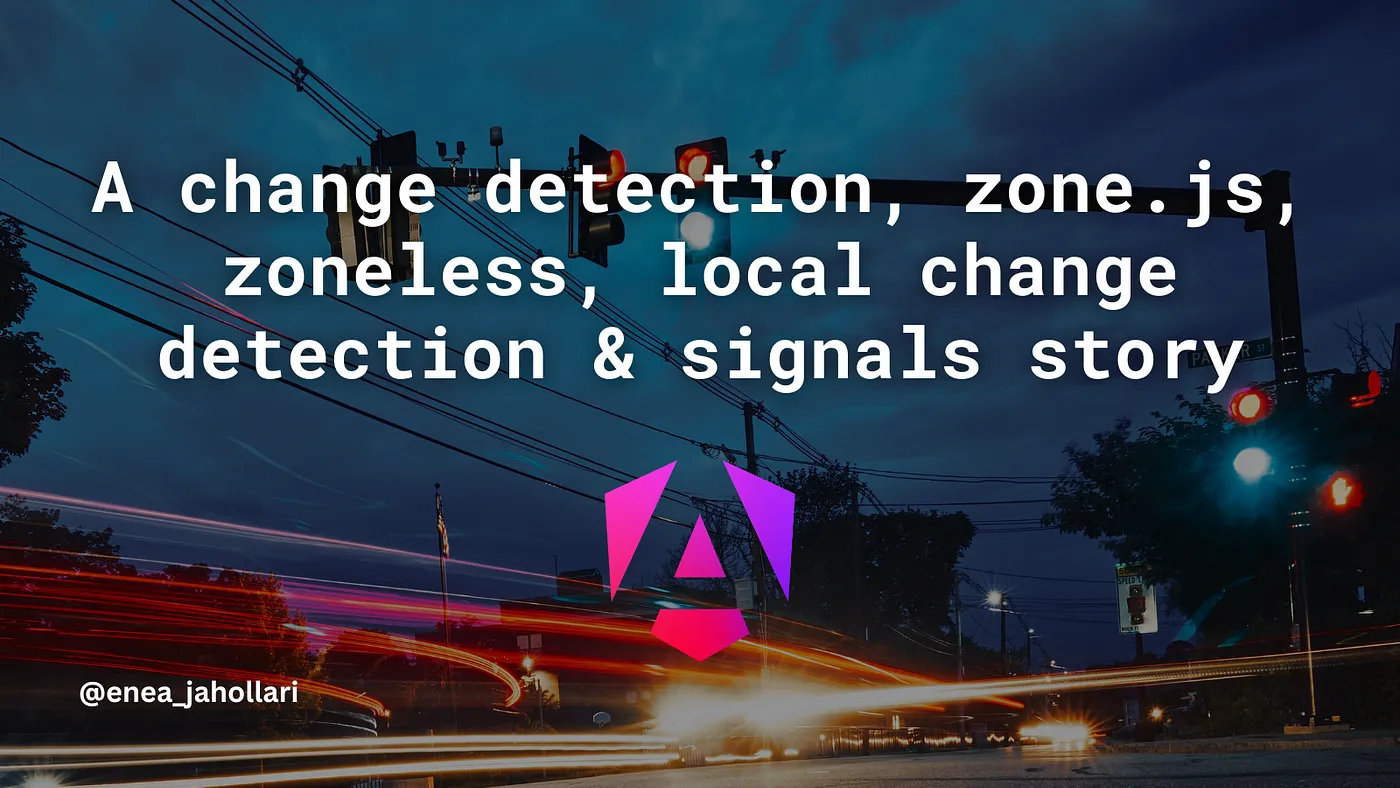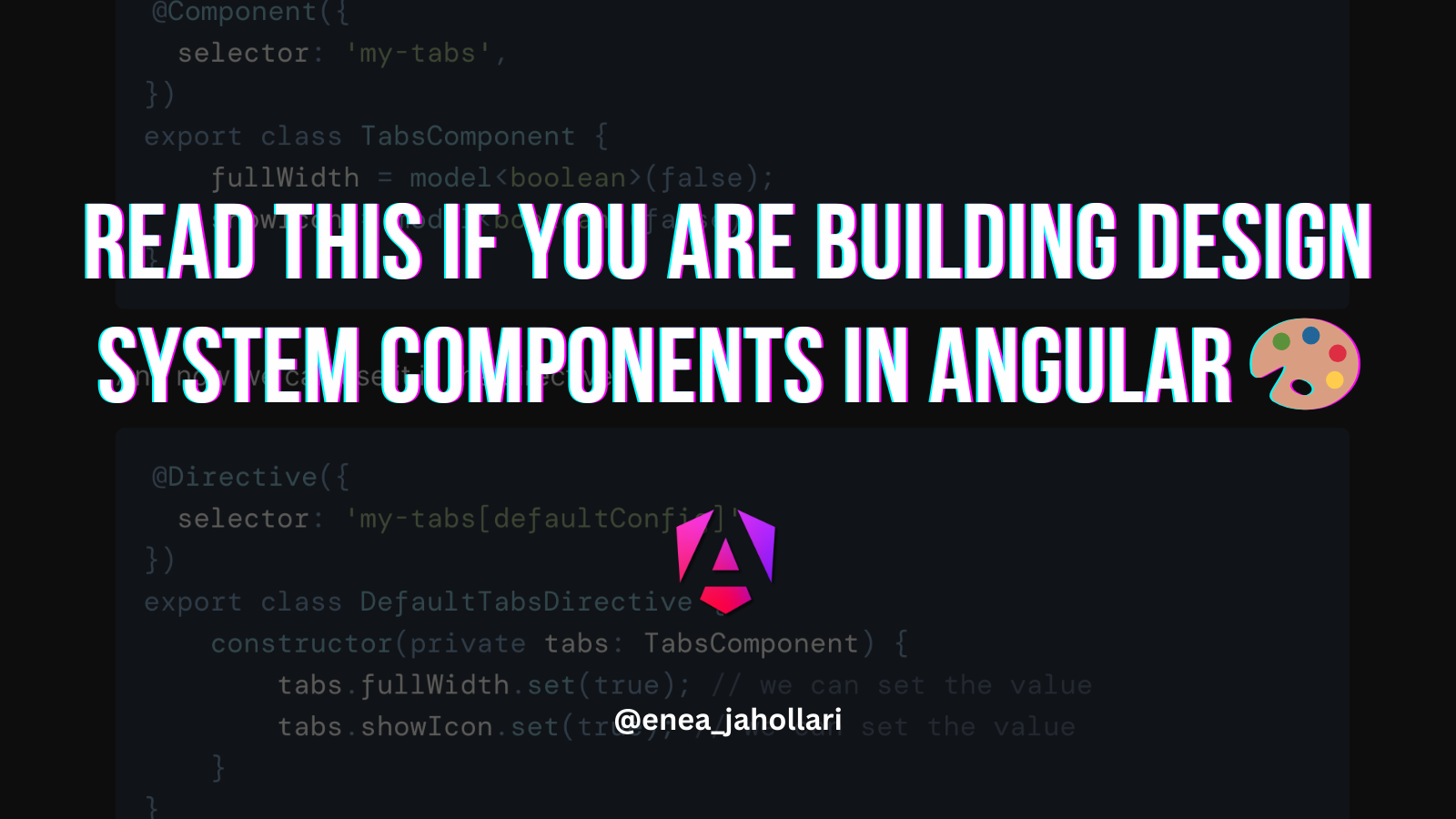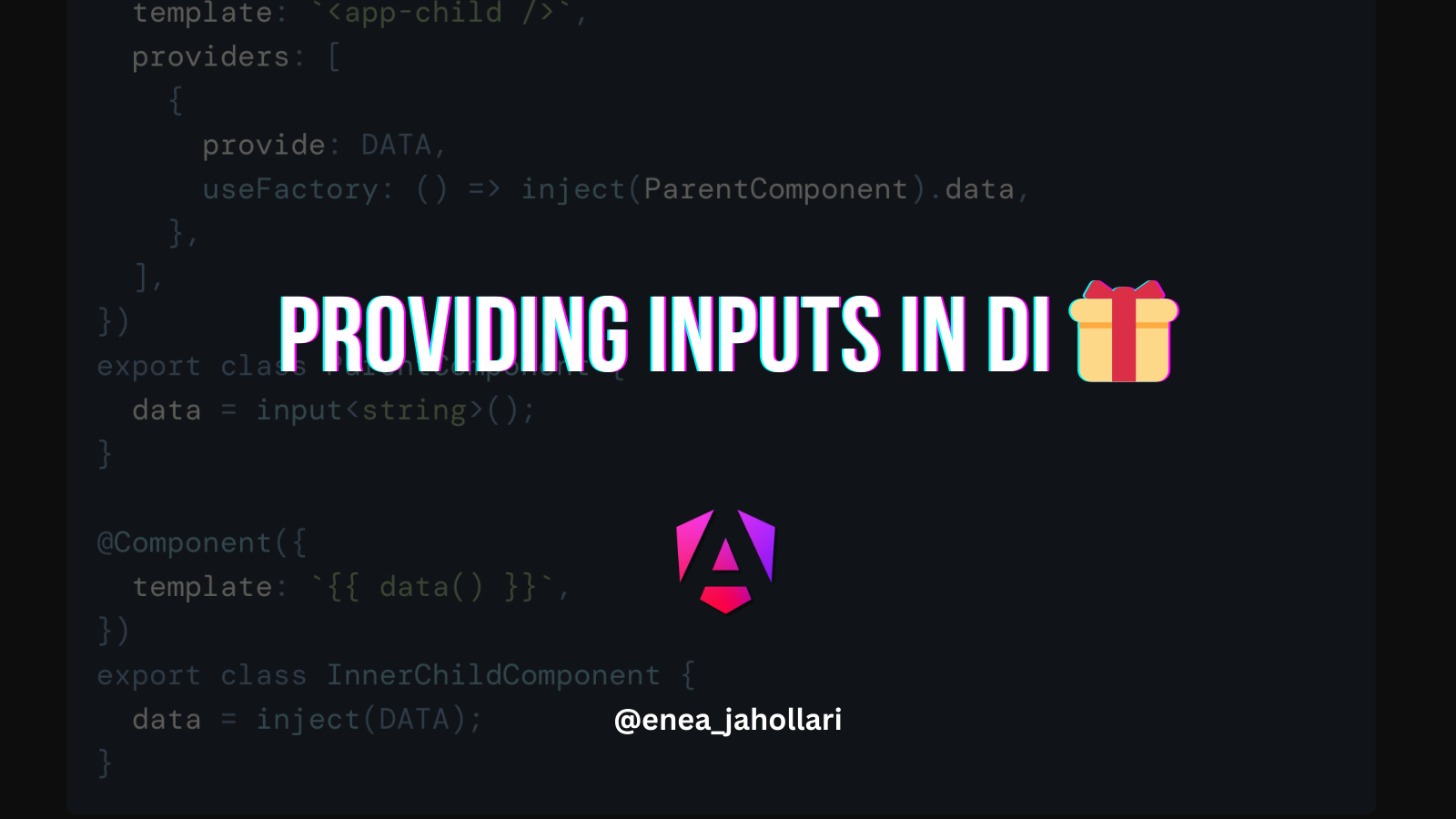A change detection, zone.js, zoneless, local change detection, and signals story 📚
Angular is a component-driven framework. And just like every other framework out there, it is supposed to show the data to the user and refresh the view when the data changes.
 A UserCard component that shows user data in the template
A UserCard component that shows user data in the template
Over time, we build more and more components and compose them together, and we may end up with a component tree like the one below.
 Component structure
Component structure
But, how does Angular know when to refresh the view? How does it know when the data changes? How does it know when to run the change detection?
Change detection with synchronous code
Let’s start with a simple example. We have a component with a property name and a method changeName. When we click the button, we call the changeName method and change the name property.
When we click the button, the changeName method is called, and because everything is wrapped by Angular, we can safely assume that after the name is changed, Angular can run some code to update the view (and everything will be in sync).
⚠️ Imaginary under the hood Angular code:
This works fine! But, most of the time when we change the data, we don’t do it synchronously. We usually make an HTTP request, or have some timers, or wait for some other events to happen before updating the data. And that’s where the problems start.
Change detection with asynchronous code
Now, let’s say that we want to change the name after 1 second. We can do that with the setTimeout function.
When we click the button, the changeName method is called, and the setTimeout function is called. The setTimeout function will wait for 1 second and then call the callback function. The callback function will change the name to Jane.
And now, let’s add the same imaginary under-the-hood Angular code as before.
⚠️ Imaginary under the hood Angular code:
Because of the call stack, the setTimeout callback will be called after the angular.runChangeDetection method. So, Angular ran the change detection but the name was not changed yet. And that’s why the view will not be updated. And that’s a broken application ⚠️. (In reality, it’s not, because we have 👇)
Zone.js to the rescue
Zone.js has been around since the early days of Angular 2.0. It is a library that monkey patches the browser APIs and enables us to hook into the lifecycle of the browser events. What does that mean? It means that we can run our code before and after the browser events.
The code above will print Hello world after 1 second. But, what if we want to run some code before or after the setTimeout callback? You know, for business reasons 😄. A framework called Angular may want to run some code before and after the setTimeout callback.
Zone.js enables us to do that. We can create a zone (Angular does create a zone too) and hook into the setTimeout callback.
To run our setTimeout inside the zone, we need to use the zone.run() method.
Now, when we run the code above, we will see the following output.
Before setTimeout
Hello world
After setTimeoutAnd that’s how zone.js works. It monkey patches the browser APIs and enables us to hook into the lifecycle of the browser events.
Zone.js + Angular
Angular loads zone.js by default in every application and creates a zone called NgZone. NgZone includes an Observable called onMicrotaskEmpty. This observable emits a value when there are no more microtasks in the queue. And that’s what Angular uses to know when all the asynchronous code is finished running and it can safely run the change detection.
 NgZone wraps every angular application today
NgZone wraps every angular application today
Let’s look at the underlying code:
What we see in the code above is that Angular will call the applicationRef.tick() method when the onMicrotaskEmpty observable emits a value. What’s this tick method 🤔? Do you remember the runChangeDetection method from the imaginary under-the-hood Angular code? Well, the tick method is the runChangeDetection method. It runs the change detection for the whole component tree synchronously.
But now, Angular knows that all the asynchronous code has finished running and it can safely run the change detection.
The tick method will iterate over all the root views (most of the time we have only one root view/component which is AppComponent) and run detectChanges synchronously.
Component Dirty marking
One other thing Angular does is that it marks the component as dirty when it knows something inside the component changed.
These are the things that mark the component as dirty:
- Events (click, mouseover, etc.)
Every time we click a button with a listener in the template, Angular will wrap the callback function with a function called wrapListenerIn_markDirtyAndPreventDefault. And as we can see from the name of the function 😅, it will mark the component as dirty.
- Changed inputs
Also, while running the change detection, Angular will check if the input value of a component has changed (=== check). If it has changed, it will mark the component as dirty. Source code here.
- Output emissions
To listen to output emissions in Angular we register an event in the template. As we saw before, the callback fn will be wrapped and when the event is emitted, the component will be marked as dirty.
Let’s see what this markViewDirty function does.
As we can read from the comment, the markViewDirty function will mark the current view and all ancestors dirty. Let’s see the image below to better understand what that means.
 Dirty marking component and its ancestor up to the root
Dirty marking component and its ancestor up to the root
So, when we click the button, Angular will call our callback fn (changeName) and because it’s wrapped with the wrapListenerIn_markDirtyAndPreventDefault function, it will mark the component as dirty.
As we said before, Angular uses zone.js and wraps our app with it.
 NgZone wraps Angular apps
NgZone wraps Angular apps
After dirty marking to the top, wrapListenerIn_markDirtyAndPreventDefault fires and triggers zone.js
 Event listeners notify zone.js
Event listeners notify zone.js
Because Angular is listening to the onMicrotaskEmpty observable, and because the (click) registers an event listener, which zone has wrapped, zone will know that the event listener has finished running and it can emit a value to the onMicrotaskEmpty observable.
 onMicrotaskEmpty fires when there’s no microtask running anymore
onMicrotaskEmpty fires when there’s no microtask running anymore
onMicrotaskEmpty tells Angular it’s time to run the change detection.
Component binding refresh
The moment Angular runs the change detection it will check every component from top to bottom. It will go over all the components (dirty and non-dirty) and check their bindings. If the binding has changed, it will update the view.

But, why does Angular check all the components 🤔? Why doesn’t it check only the dirty components 🤔?
Well, because of the change detection strategy.
OnPush Change Detection
Angular has a change detection strategy called OnPush. When we use this strategy, Angular will only run the change detection for a component that is marked as dirty.
First, let’s change the change detection strategy to OnPush.
Let’s look at the graphic below to better understand how the change detection works with the OnPush strategy.

Let’s do the same thing as before. Click a button in the component and change the name.
First, we will have the Dirty Marking phase.

Then, the event listener will notify zone.js.
 Event notifies zone.js
Event notifies zone.js
When everything async has finished running, onMicrotaskEmpty will fire.

Now, Angular will run the tick method, and what it will do is traverse all components from top to bottom and check each component.
If the component is:
- OnPush + Non-Dirty -> Skip
- OnPush + Dirty -> Check bindings -> Refresh bindings -> Check children

As we can see, by using OnPush we can skip parts of the tree that we know haven’t had any changes.
OnPush + Observables + async pipe
When we work with Angular, observables have been our number one tool to manage data and state changes. To support observables, Angular provides the async pipe. The async pipe subscribes to an observable and returns the latest value. To let Angular know that the value has changed, it will call the markForCheck method that comes from the ChangeDetectorRef class (the component’s ChangeDetectorRef).
I’ve written more about it here (create async pipe from scratch and understand how it works):
And what the markForCheck method does is that it will just call the markViewDirty function that we saw before.
So, the same as before, if we use observables with async pipe in the template it will act the same as if we used the (click) event. It will mark the component as dirty and Angular will run the change detection.
 data$ | async pipe marks component as dirty
data$ | async pipe marks component as dirty
OnPush + Observables + Who is triggering zone.js?
If our data changes without our interaction (click, mouseover etc.) probably there is a setTimeout or setInterval or an HTTP call being made somewhere under the hood that triggers zone.js.
Here’s how we can easily break it 🧨
What we have done here is:
- In
ngOnInit, we have usedngZone.runOutsideAngular()an API that allows us to run things outside the Angular zone. - We use
setTimeout(to skip the first task being run and also because Angular runs change detection at least once by default) and inside thesetTimeout, we assign a value to the observable (yay we have a change). - Because
setTimeoutwon’t run inside the zone, also the API call will be made outside the zone because the code is run insiderunOutsideAngular, there is nothing notifying zonejs that something changed. - Run this code in your app and see that only “[]” will be shown in the browser.
- Broken State 🧨!
Not great 😄! But, one other thing that we start questioning is:
Why do we need to mark all the ancestors dirty?
The reason for this is simple, if we don’t mark all ancestors as dirty, we can get a broken state even faster. How?
Let’s see the above example again, but now, mark only the component and its children as dirty.

So, we mark only the component that had the click and its children to be marked for check. The moment the tick happens it will get to the parent component which is OnPush, check that it’s not dirty, and skip it.
 Broken state if we don’t mark ancestors as dirty when using markForCheck
Broken state if we don’t mark ancestors as dirty when using markForCheck
That’s how we get to a broken state again 🧨!
Why can’t we just run the change detection for the component that is marked as dirty?
We can do that using the detectChanges method in the ChangeDetectorRef class. But it has its drawbacks. Because that method runs change detection synchronously, it can cause performance issues. Because everything will be done in the same browser task, it may block the main thread and cause jank. Imagine detecting changes for a list of 100 items every 1 or 2 seconds. That’s a lot of work for the browser.
markForCheck vs detectChanges (coalesced run vs sync runs)
When we use markForCheck we just tell Angular that a component is dirty, and nothing else happens, so even if we call markForCheck 1000 times it’s not going to be an issue. But, when we use detectChanges, Angular will do actual work like checking bindings and updating the view if needed. And that’s why we should use markForCheck instead of detectChanges.
Can’t we schedule detectChanges in the next browser task?
We can, that’s what push pipe or rxLet directive from rx-angular does. It schedules the change detection in the next browser task. But, it’s not a good idea to do that for every component. Because, if we have a list of 100 items, and we schedule the change detection for every item, we will have 100 browser tasks. And that’s not good for performance either.
Signals 🚦
The frontend world is moving towards signals. Solid.js, Svelte, Vue, and Angular are creating their signal implementations. And that’s because signals are a better way to manage state and state changes.
Signals in Angular have brought a lot of DX benefits. We can easily create and derive state and also run side effects when the state changes using effects. We don’t have to subscribe to them, we don’t have to unsubscribe from them, and we don’t have to worry about memory leaks 🧯.
We can just call them and they will return their current value.
We can also use signals in the template just like normal function calls.
If you ask if calling a function in the template is a good idea, I would say that it’s a good idea if the function call is cheap, and calling a signal is cheap. It’s just a function call that returns a value (without computing anything).
I’ve also written about it here:
Signals and Change Detection
In v17 Angular change detection got an upgrade 🚀!
Angular templates now understand signals as something more than function calls. Below is one of the PRs making this a reality.
feat(core): Mark components for check if they read a signal
Before we used the async pipe, so it would call the markForCheck method, and with signals, we just have to normally call them. Angular now will register an effect (consumer) that will listen to this signal and mark the template for check every time the signal changes.
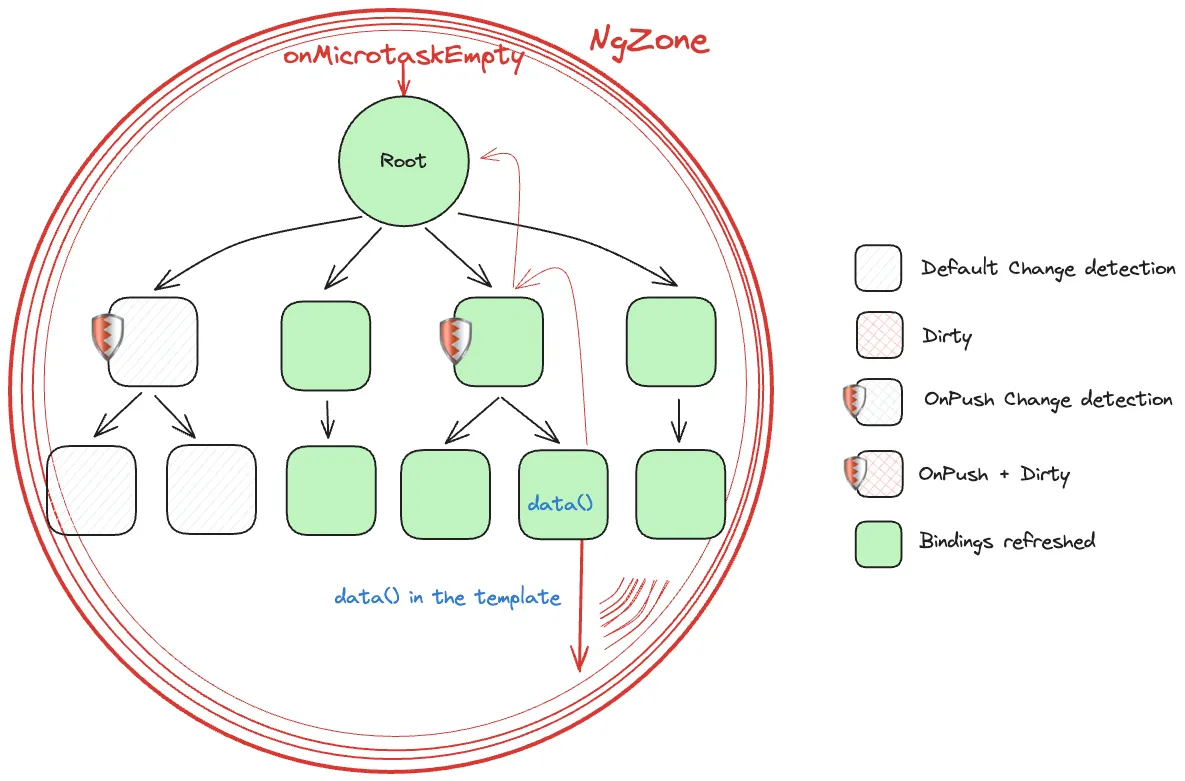
The first benefit is that we don’t need async pipe anymore 🎉.
The second PR that improves change detection is this one:
fix(core): Ensure backwards-referenced transplanted views are refreshed
Which solved an issue not related to signals but to change detection itself (which I won’t explain in detail).
By using the mechanism introduced by it, we got the 3rd PR which added Glo-cal change detection (Global + Local change detection) (a term coined by my friend @Matthieu Riegler)
perf(core): Update LView consumer to only mark component for check
So let’s better understand glo-cal (local) change detection 👇
Local Change Detection (Targeted mode)
One of those PRs I linked above introduced two new flags in Angular.
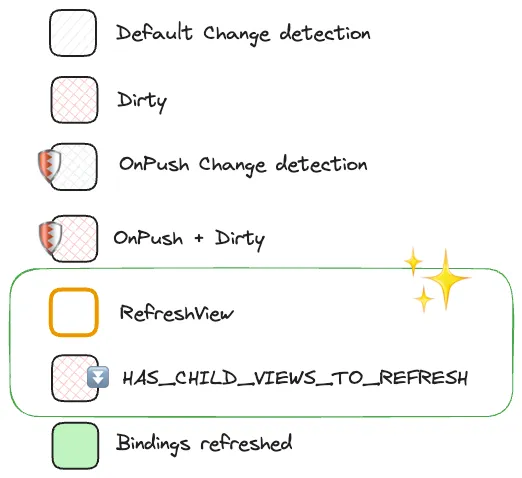 Two new flags (RefreshView & HAS_CHILD_VIEWS_TO_REFRESH)
Two new flags (RefreshView & HAS_CHILD_VIEWS_TO_REFRESH)
How do they work?
When the template effect runs, Angular will run a function called markViewForRefresh which sets the current component flag to RefreshView and then calls markAncestorsForTraversal which will mark all the ancestors with HAS_CHILD_VIEWS_TO_REFRESH.
And here’s how it looks in the graph (updated tree structure to showcase more edge cases)👇
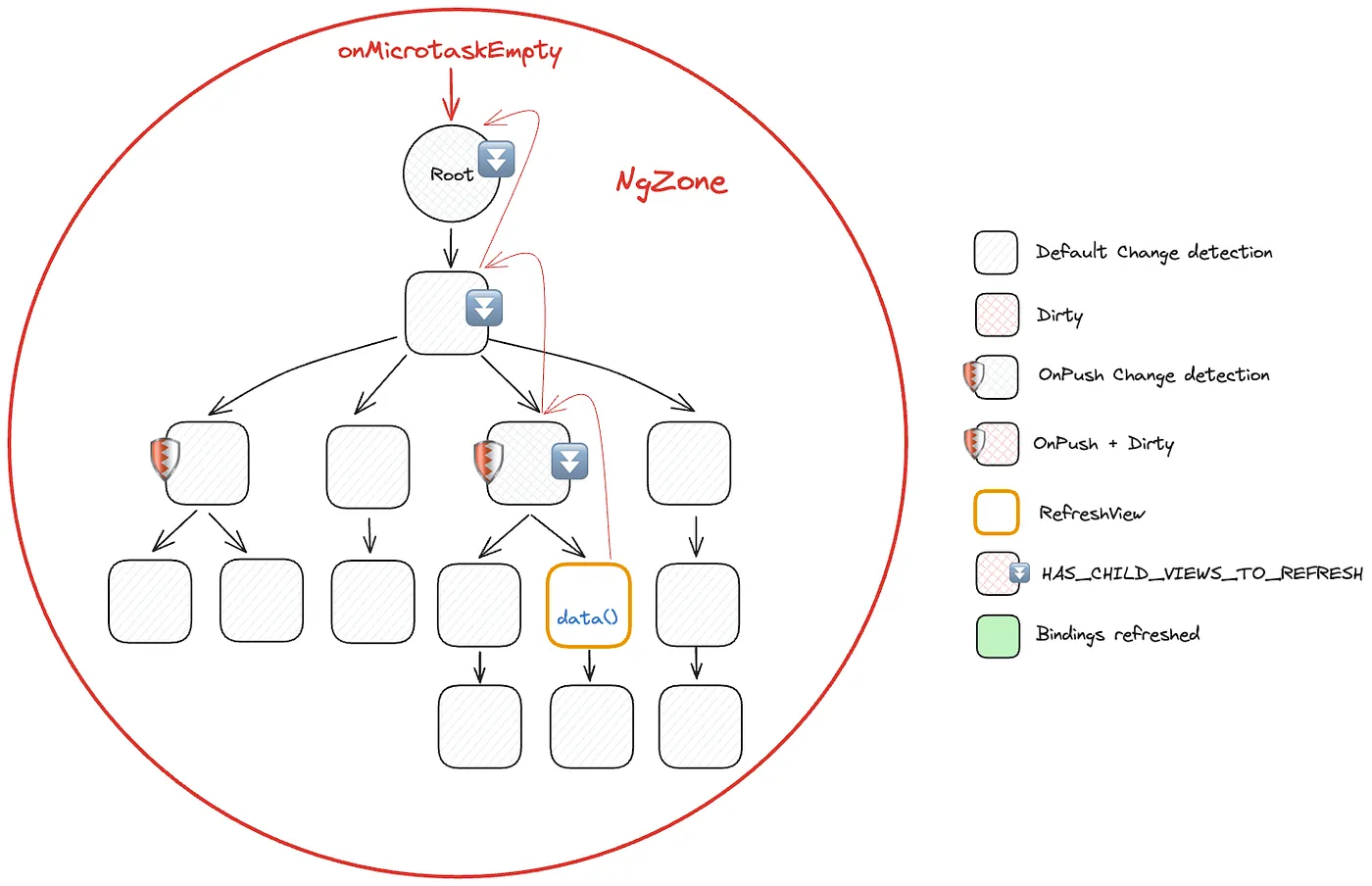
So, the component that has signal changes is marked with the orange color border and the parents now have the ⏬ icon to tell that they have child views to refresh.
NOTE: We still depend on zone.js to trigger change detection.
The moment zone.js kicks in (the same reasons as before) it will call appRef.tick() and then we will have top-down change detection with some differences and new rules!
Targeted Mode Rules
NgZone triggers change detection in GlobalMode (it will go top-down checking & refreshing all components)
In GlobalMode we check CheckAlways (normal component without any change detection strategy set) and Dirty OnPush components
What triggers TargetedMode?
- When in
GlobalModewe encounter aNon-Dirty OnPushcomponent, we switch toTargetedMode!
In TargetedMode:
- Only refresh a view if it has the
RefreshViewflag set - DO NOT Refresh
CheckAlwaysor regularDirtyflag views - If we reach a view with
RefreshViewflag, traverse children inGlobalMode
Let’s go one by one on components.
- Root component is a normal component (
CheckAlways) so we just check & refresh bindings if needed and we continue to its children.
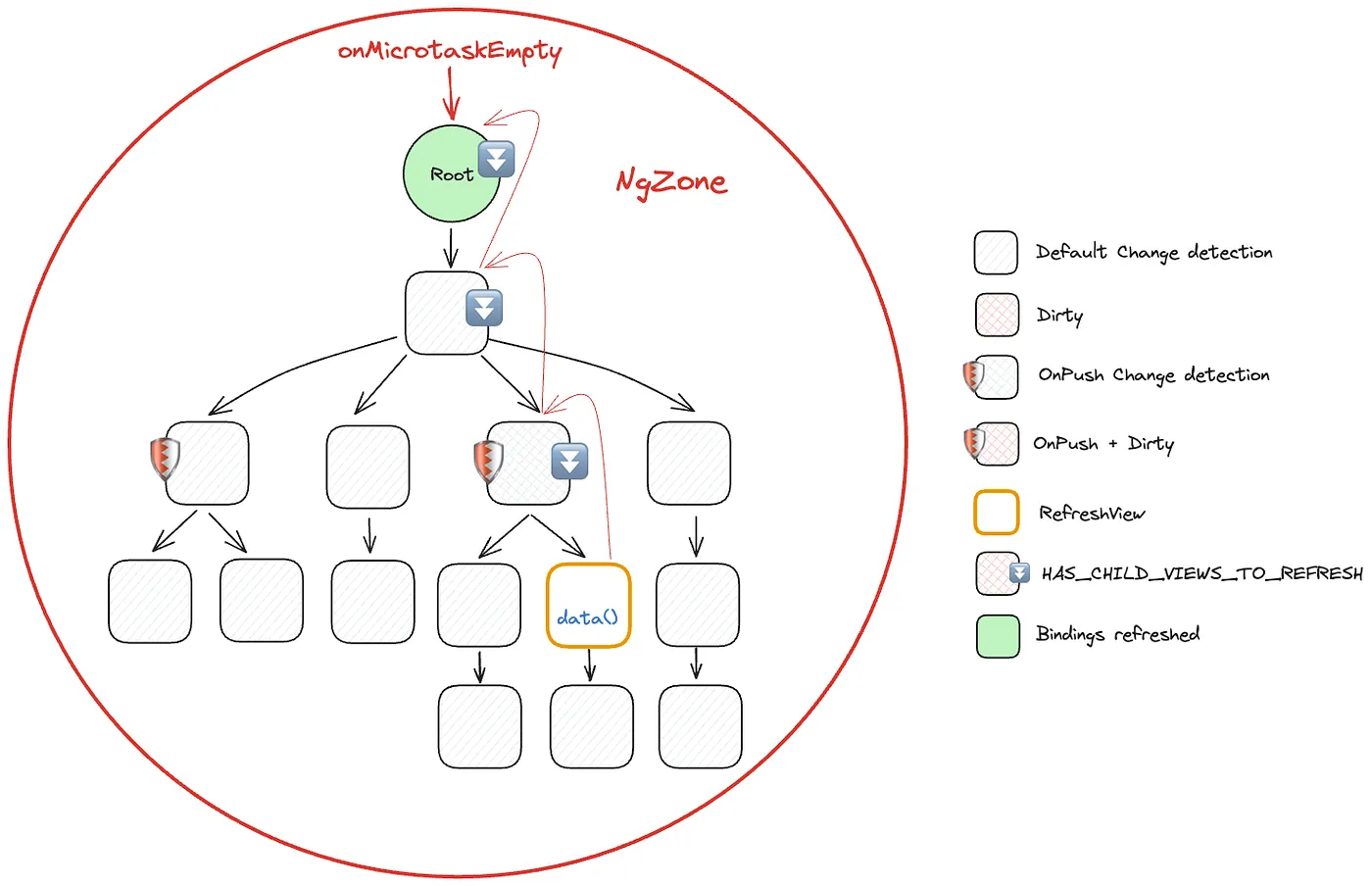
- All
CheckAlwayscomponents will continue to work the same as before.
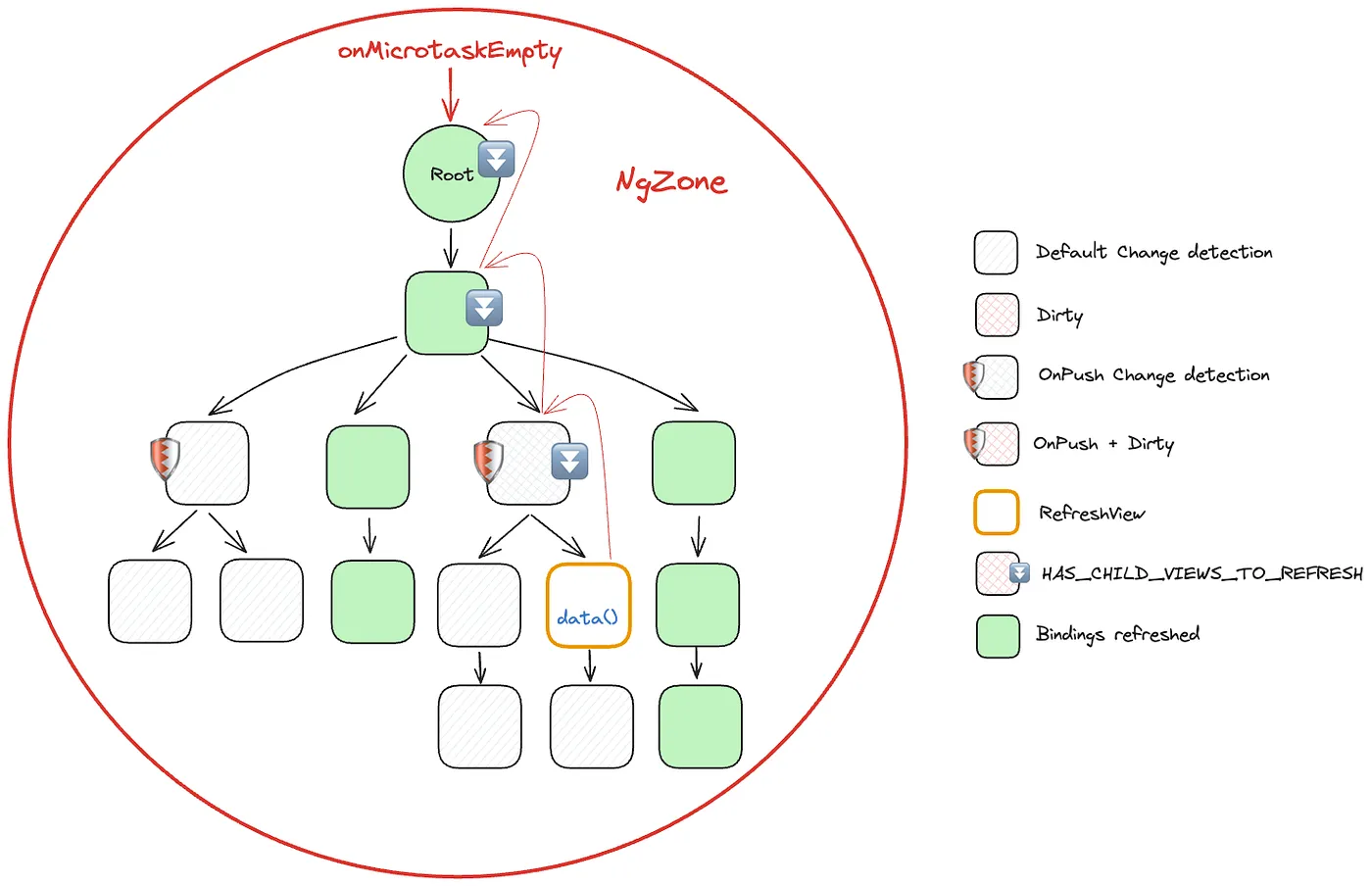 All CheckAlways components are refreshed
All CheckAlways components are refreshed
OnPush will continue to work the same, so if it’s not marked as dirty it won’t be checked.
If we check the other component that is OnPush + HAS_CHILD_VIEWS_TO_REFRESH but not dirty we get our trigger for
TargetedMode(check the rules above)
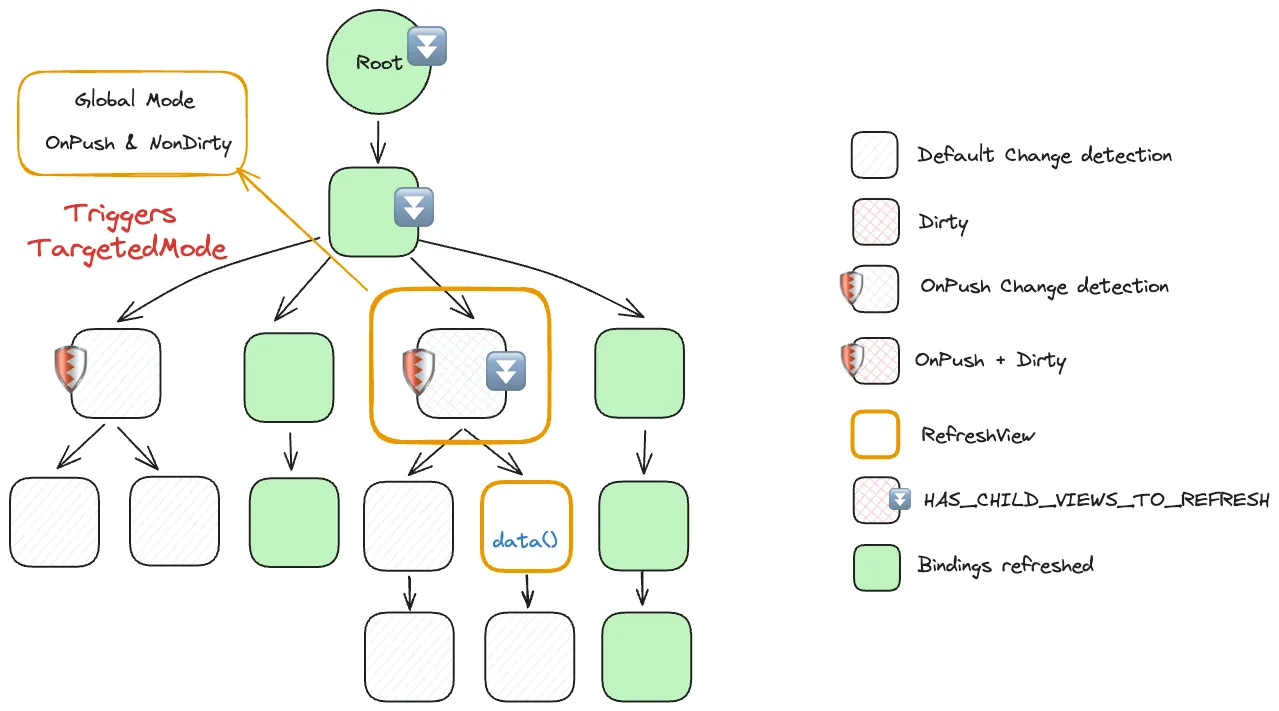
- The component itself is not going to be refreshed, let’s go to the children
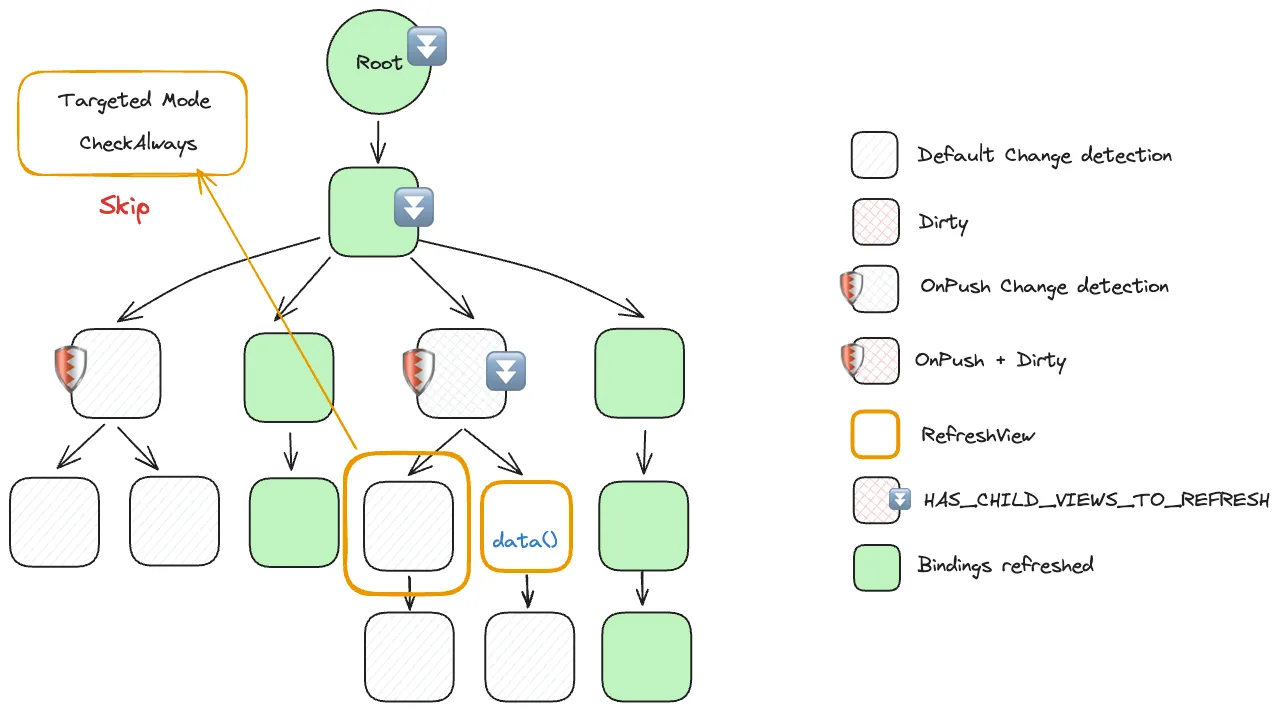 TargetedMode on CheckAlways component -> Skip
TargetedMode on CheckAlways component -> Skip
- Then we reach a
RefreshViewcomponent and we are onTargetedMode, which means we refresh the bindings. We also convert toGlobalModeto make sureCheckAlwayschildren components also get refreshed correctly.

- Now we are in
GlobalModeand we have aCheckAlwayscomponent, so we just refresh normally

That’s all about the new Targeted Change Detection.
If we look at the final tree, we can see that we skipped more components than before when we reach an OnPush component that is not dirty.
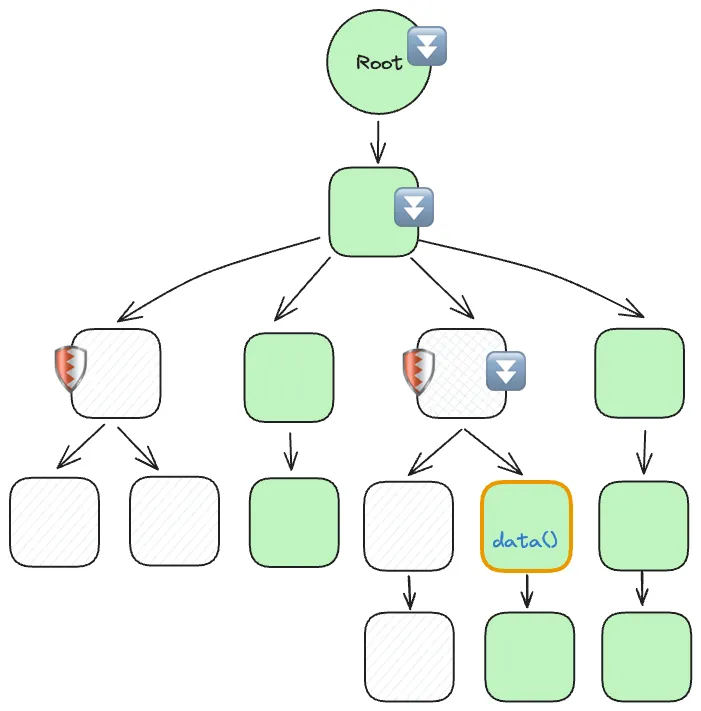
Targeted Change Detection = OnPush without footguns 🔫
You can play with all these change detection rules in this app by Mathieu Riegler 🔨
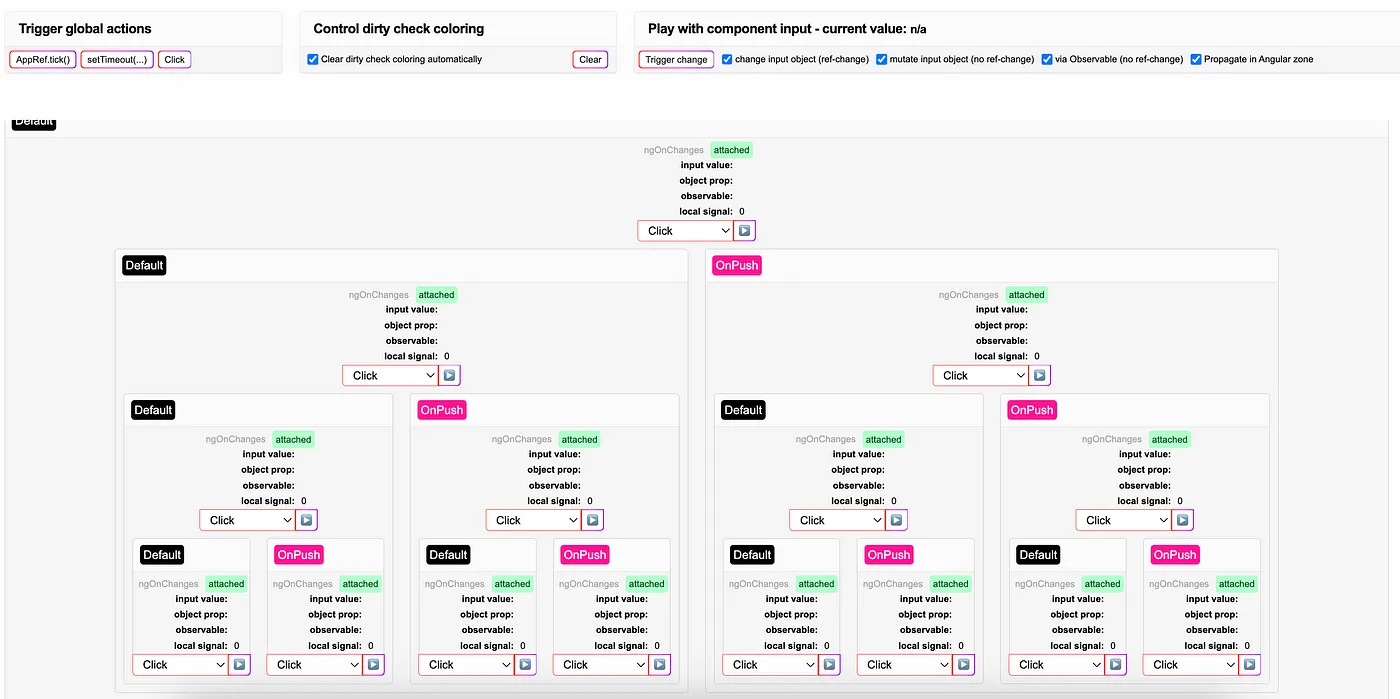
Angular Change Detection Playground
Zoneless Angular — Let’s remove zone.js from Angular
The moment we remove zone.js from Angular we are left with code that runs but doesn’t update anything in the view (The bootstrap time of zone.js and all the pressure it puts in the browser gets removed too! We also remove 15kb from the bundle size 😎). Because nothing is triggering appRef.tick().
But, Angular has some APIs that tell it that something changed. Which ones?
- markForCheck (used by async pipe)
- signal changes
- event handlers that mark view dirty
- setting inputs on components created dynamically with setInput()
Also, OnPush components already works with the idea that it needs to tell Angular that something changed.
So, instead of having zone.js schedule tick() we can have Angular schedule tick() when it knows something changed.
refactor(core): Add scheduler abstraction and notify when necessary
In this PR (experimental) we can see that markViewDirty now will notify the changeDetectionScheduler that something changed.
The scheduler is supposed to schedule tick(), as we can see in this other experimental implementation of a zoneless scheduler.
Add zoneless scheduler to the ApplicationRef.isStable indicator
This is experimental, but we can see that basically, it will coalesce all notify() calls and run them only once (in this code is only once per macroTask — setTimeout, but maybe we get it only once per microTask — Promise.resolve())
What are we supposed to understand from this?
Apps that are currently using the OnPush change detection strategy will work fine in a zoneless angular world.
Zoneless Angular !== Glo-cal (local) change detection
Zoneless Angular is not the same as local change detection. Zoneless Angular is just removing zone.js from Angular and using the APIs that Angular already has to schedule tick().
Real Local change detection is a new feature that will allow us to run change detection for only a sub-tree of components (not the whole component tree) that currently use the OnPush change detection strategy.
Signals change detection (No OnPush, No Zone.js, Signals only)
One thing signal change detection will bring is native unidirectional data flow (two-way data binding without headaches).
Watch this video Rethinking Reactivity w/ Alex Rickabaugh | Angular Nation
While glo-cal change detection with OnPush and zoneless are great, with only signal components, we probably can do even better.
What if we didn’t have to use OnPush? Or run change detection for the whole component tree? What if we could just run change detection for the views inside components that have changed?
Read more in the RFC:
Sub-RFC 3: Signal-based Components
Credits where it’s due:
- Alex Rickabaugh for answering all my questions about Angular
- Andrew Scott for every PR he has created till now
- Chau Tran and Matthieu Riegler for the discussions about Angular internals
- Michael Hladky Julian Jandl Kirill Karnaukhov Edouard Bozon Lars Gyrup Brink Nielsen (RxAngular team)
- The whole Angular team for the wonderful job they have been doing!
Thanks for reading!
If this article was interesting and useful to you, and you want to learn more about Angular, support me by buying me a coffee ☕️ or follow me on X (formerly Twitter) @Enea_Jahollari where I tweet and blog a lot about Angular latest news, signals, videos, podcasts, updates, RFCs, pull requests and so much more. 💎
